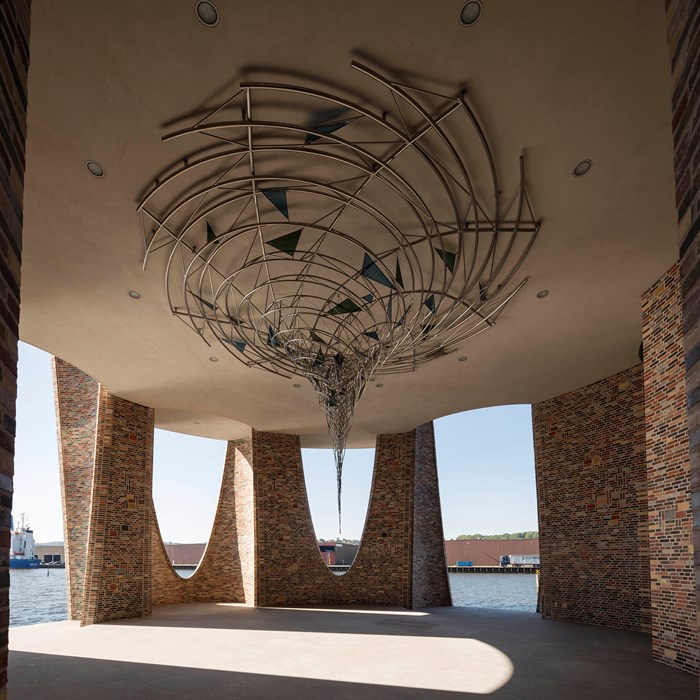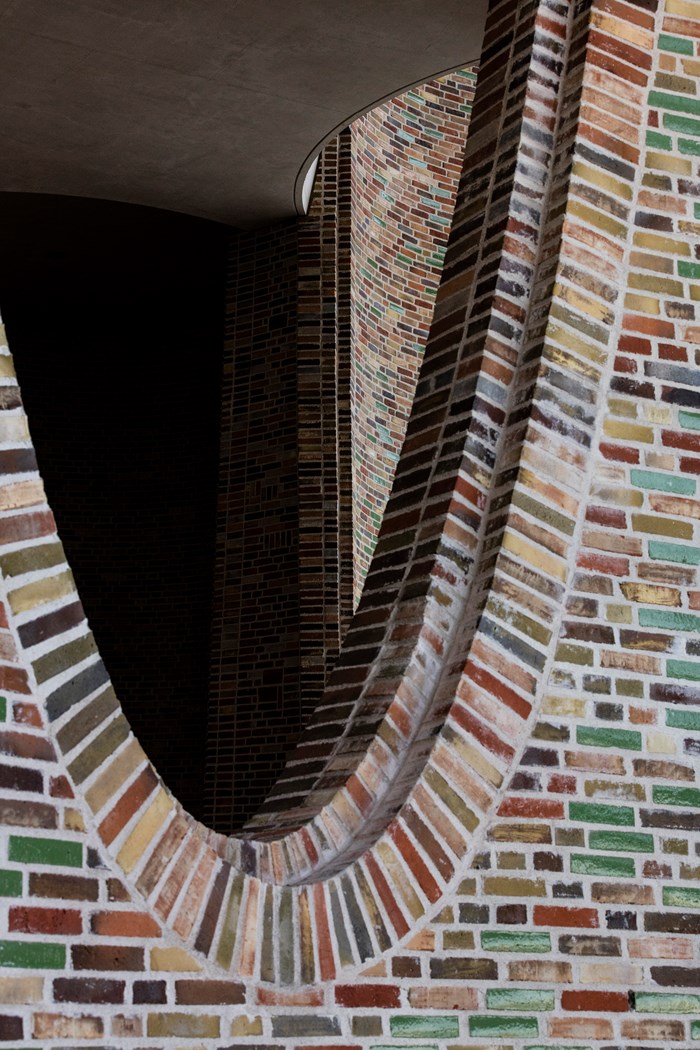Fjordenhus (Fjord House), the first building designed entirely by artist Olafur Eliasson and the architectural team at Studio Olafur Eliasson, opened on 9 June in Vejle, Denmark. Commissioned by KIRK KAPITAL A/S, the company’s new headquarters offer a contemporary interpretation of the idea of the total work of art, incorporating remarkable site-specific artworks by Eliasson with specially designed furniture and lighting.
Rising out of the water, Fjordenhus forges a striking new connection between Vejle Fjord and the city centre of Vejle—one of Jutland peninsula’s thriving economic hubs. As one moves from the train station towards the harbour, Fjordenhus comes into view across the expansive plaza of the man-made `Havneøen´, a mixed-use residential and commercial area currently in development. From here, residents and visitors can access the ground floor of Fjordenhus via a footbridge or stroll along the jetty designed by landscape architect Günther Vogt.
The history behind Fjordenhus told by KIRK KAPITALS shareholders
The building’s semi-public, double-height entrance level is dedicated to the relation of the building to the water, drawing attention to the plane where the supporting pillars plunge beneath the surface, their curved edges framing glimpses of the surrounding shores and harbour. The building is permeated by the harbour itself, and its two aqueous zones are visible from viewing platforms. Both the architectural spaces and Eliasson’s artworks engage in a dialogue with the ever-changing surface of the water.
Formed by four intersecting cylinders, Fjordenhus soars to a height of twenty-eight metres (92 feet). Rounded negative volumes have been carved from its façades of custom-glazed brick to create an extraordinary architectural statement of complex curved, circular, and elliptical forms, torqueing walls and parabolic arches.
Olafur Eliasson tells about Fjordenhus
Olafur Eliasson notes
‘I am very thankful for the trust shown by the Kirk family in inviting me, with my studio, to conceive Fjordenhus. This allowed us to turn years of research—into perception, physical movement, light, nature, and the experience of space—into a building that is at once a total work of art and a fully functional architectural structure. In the design team, we experimented from early on with how to create an organic building that responded to the ebb and flow of the tides, to the shimmering surface of the water, changing at different times of the day and of the year.`

Sebastian Behmann, head of design at Studio Olafur Eliasson, says,
‘Throughout the process, we were very attentive to the choreography and sequencing of spaces using modulation of light and acoustics to heighten all the building’s sensory aspects. One experiences Fjordenhus as a sculptural presence in the harbour, an interaction of solids and voids. These voids—the main points of interaction between inside and outsid —are the major design element and form the parabolic, multi-story windows. Our clients grasped the value of devoting the ground story of the building, alongside the plaza with its jetty, to the experience of the building’s relation to its environment—and to the public.’
About Olafur Eliasson:
Artist Olafur Eliasson (Iceland/Denmark), born in 1967, works in a wide range of media, including installation, painting, sculpture, photography, and film. Since 1997, his solo shows have appeared in major museums around the world. As part of his practice, he engages with arts education, policy-making, and issues of sustainability and climate change. Eliasson’s architectural projects include the Serpentine Gallery Pavilion 2007, designed together with Kjetil Thorsen; Your rainbow panorama, a 150-metre circular, coloured-glass walkway situated on top of ARoS Museum in Aarhus, Denmark (2011); and Harpa Reykjavik Concert Hall and Conference Centre (2005-2011), which won the Mies van der Rohe Award in 2013 and for which Eliasson created the façades in collaboration with Henning Larsen Architects. olafureliasson.net
About Sebastian Behmann:
Architect Sebastian Behmann, born in Germany in 1969, has worked with Olafur Eliasson since 2001 and is head of the department of design at Studio Olafur Eliasson, as well as co-founder of Studio Other Spaces. Major projects with Eliasson include Serpentine Gallery Pavilion 2007 in London and Cirkelbroen (The circle bridge) in Copenhagen (2015).
About Studio Olafur Eliasson:
The team at Studio Olafur Eliasson consists of over one hundred people, from craftsmen and specialised technicians to architects, archivists, researchers, art historians, cooks, and administrators. They work with Eliasson to develop, produce, and install artworks, projects, and exhibitions, as well as on experimentation, archiving, research, publishing, and communications. In addition to realising artworks in-house, Eliasson and the studio work with structural engineers and other specialists and collaborate worldwide with cultural practitioners, policymakers, and scientists.
Facts about the construction of Fjordenhus
